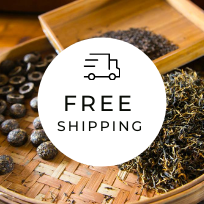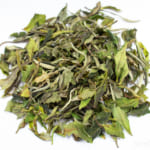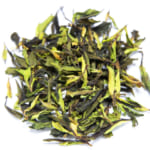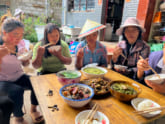- HOME >
- Origin of Tea
Yunnan 2024 Spring Tea Sourcing
- [2024.04.10] Posted By Akira Hojo

Yunnan Province is globally renowned for the exceptional quality of its tea leaves. However, lax production management often presents challenges in achieving the desired tea quality when relying solely on pre-made teas. To address this issue, we have committed to remaining on-site throughout the spring season to closely monitor tea production. We are meticulously inspecting tea gardens to ensure they meet our standards regarding the growing environment of tea trees and tea processing methods. Additionally, we are vigilantly monitoring daily weather changes to manage production conditions effectively. Our goal is to collaborate with tea makers to produce the finest quality tea.
Although we anticipated that teas from old tea trees would be ready for plucking from April onwards, we arrived in Yunnan in March, before the peak tea plucking season begins. This early arrival allows us to survey the conditions of the tea gardens before finalizing which ones are suitable for our teas.
First and foremost, it is crucial to ensure that the tea gardens are in a natural farming state and are independent, without neighbouring plantations of other agricultural products such as maize or walnuts. This precaution is necessary because pesticides or herbicides are commonly used on these neighbouring crops, posing a high risk of contamination. Therefore, we must identify specific gardens and make advance arrangements for tea pluckers to collect fresh tea leaves only from the gardens we have approved.

Currently, our plan is to stay in Yunnan Province until May.
The tea of 2024 boasts exceptional quality
This year, in the Lincang region, there has been significantly less rainfall since last December, resulting in overall dry conditions. Consequently, the tea plants have been growing slowly, indicating a high-quality year for tea production.
During the last week of March, we experienced almost daily evening showers, providing just the right amount of moisture to the tea trees. As a result, starting from April, tea in the area at around 2000m elevation has begun to reach its picking season simultaneously. However, it’s worth noting that tea trees aged around 300 years and above have a much slower growth rate, and their harvesting is expected to commence towards the end of this month or the beginning of May, even at the same elevation.

The tea season begins with white tea production
From March to mid-April, the weather tends to be relatively cooler with lower ambient temperatures, making it ideal for white tea production. At present, we are fully immersed in producing white tea. The quality of white tea is significantly influenced by the weather. In the event of poor weather conditions, such as cloudy or rainy days, we employ various methods, such as using fans, to ensure proper ventilation; otherwise, the tea may develop a musty odour. The optimal period for producing high-quality white tea is quite limited, and we consider this week to be crucial for our endeavours in this regard.


Revising the processing method for raw pu-erh tea.
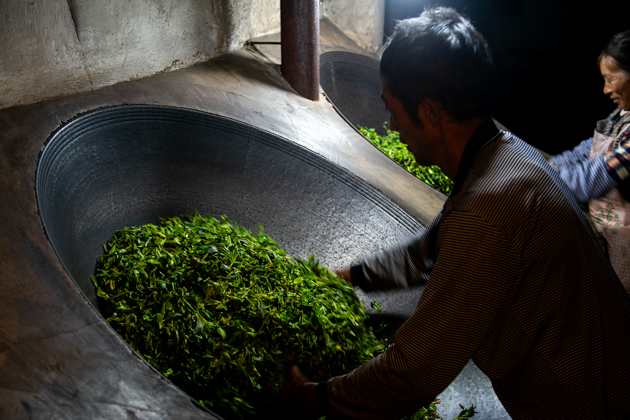

Regarding raw pu-erh tea, our intention is to collect tea leaves from older tea trees in the higher-elevation tea gardens, which will be ready for plucking starting next week. However, before that, we are currently revising the pan-frying method. This adjustment is necessary due to the processing parameters becoming erratic during the COVID period. As teas from excellent gardens such as Ming Feng Shan, Tang Jia, and Da Cha Lin become ready for plucking next week, our goal is to stabilize the pan-frying method by then.
Experimenting with tea processing methods to enable small-scale farmers to produce black tea.
This year, we are also venturing into black tea experimentation. While the Yunnan black teas we typically source are crafted by specialized black tea producers, I am keen on exploring the development of black tea using the same raw materials employed for Pu-erh tea and white tea. To achieve this, we aim to implement a more straightforward tea-making method that even small-scale farmers can utilize, capitalizing on their abundant resources of old tea trees and existing facilities. Building upon parameters used in the traditional black tea production method prevalent in Yunnan, we are refining the process to enhance the cup characteristics of the black tea in terms of flavor and taste. Hopefully, we may be able to produce black tea with a robust, distinctive aftertaste akin to that of Pu-erh tea. However, we are still in the process of achieving this goal.
Related Articles
How to get the latest update on HOJO Tea?
1. Follow Twitter, 2. Click "Like" on Facebook, and 3. Subscribe in newsletter. You can have the latest tea news from HOJO Tea.
 Subscribe the Newsletter to enjoy the privileges
Subscribe the Newsletter to enjoy the privileges- You may receive a free sample upon purchase, or you may have the priority to purchase special products. So please remember to subscribe our newsletter as well as the social network.
- Yunnan Chun Jian Green Tea from High Mountain Gardens
- Yunnan Chun Jian Green Tea is now available.This tea is made from naturally grown leaves harvested from high mountain gardens at 2100m above sea level. It has a rich, long-lasting lingering aftertaste, comparable to raw Pu-erh tea. Yunnan as a Distinctive Tea Growing Region Over the past 20 years, we have explored a wide range …
- Limited Loose Leaf Release of 2025 Da Xue Shan Wild Raw Pu-erh Tea
- We have released the 2025 loose-leaf version of Da Xue Shan Wild Raw Pu-erh Tea.This tea comes from wild tea trees that grow naturally in the high mountains of Yunnan Province, at elevations above 2000 meters. This year, we were only able to secure a small quantity for retail, and the current release is available …
NEW ARTICLES
 Yunnan Chun Jian Green Tea from High Mountain Gardens
Yunnan Chun Jian Green Tea from High Mountain Gardens- Yunnan Chun Jian Green Tea is now available.This tea is made from naturally grown leaves harvested from high mountain gardens at 2100m above sea level. It has a rich, long-lasting lingering aftertaste, comparable to raw Pu-erh tea. Yunnan as a Distinctive Tea Growing Region Over the past 20 years, we have explored a wide range …
 Limited Loose Leaf Release of 2025 Da Xue Shan Wild Raw Pu-erh Tea
Limited Loose Leaf Release of 2025 Da Xue Shan Wild Raw Pu-erh Tea- We have released the 2025 loose-leaf version of Da Xue Shan Wild Raw Pu-erh Tea.This tea comes from wild tea trees that grow naturally in the high mountains of Yunnan Province, at elevations above 2000 meters. This year, we were only able to secure a small quantity for retail, and the current release is available …
 2025 Da Xue Shan Wild White Tea Now Available from Yunnan
2025 Da Xue Shan Wild White Tea Now Available from Yunnan- The 2025 harvest of Da Xue Shan Wild White Tea is now available. Crafted from truly wild Camellia taliensis trees growing naturally in the high-altitude forests of Yunnan, this tea offers a purity and character unique to its origin. This year’s unusually dry climate during the withering season was ideal, resulting in a floral and …
 Why Do Some Teas Taste Astringent? Exploring the Causes and Mechanisms of Astringency
Why Do Some Teas Taste Astringent? Exploring the Causes and Mechanisms of Astringency- Tea can range from having no noticeable astringency to possessing a very strong one. What causes this astringency? This article explores the causes and mechanisms behind astringency in tea. Causes of Astringency Astringency arises from the binding of tea components to proteins in the oral cavity, creating a sensation of tightness or dryness. The tongue …
 The Impact of Heat Sources on Tea Flavor
The Impact of Heat Sources on Tea Flavor- It is widely recognized that the material of a kettle plays an important role in shaping the taste of water for brewing tea. Yet, an often overlooked but equally significant factor is the type of heat source used to boil the water. Different heat sources, whether gas, electric, charcoal, or wood fire, can impart distinct …
 New Release of High Mountain White Tea
New Release of High Mountain White Tea- We are pleased to introduce our High Mountain White Tea, sourced from a unique tea garden with two key features: 1. Located at an altitude of 2200-2300m2. Completely wild and untended The ideal natural conditions of this garden result in tea of exceptional quality, offering a pure and gentle, nourishing taste. High Altitude and Wild …
 New Release of Da Xue Shan Wild White Tea 2024
New Release of Da Xue Shan Wild White Tea 2024- We have released the 2024 Da Xue Shan Wild White Tea Loose Leaf. This tea was produced under our direct supervision during our stay in Yunnan Province, ensuring meticulous production management on site. Definition of Wild Tea in Yunnan Province People in Yunnan strongly associate Camellia taliensis with wild tea, regardless of where it is …
 New Release of Wild Pu-erh Jasmine Pearl
New Release of Wild Pu-erh Jasmine Pearl- Out of curiosity, we decided to create a jasmine tea based on Da Xue Shan Wild Raw Tea. This resulted in an exceptionally rare tea, not only in Japan but also in China. Custom Production Network for Jasmine Tea At our store, we source various types of base teas from different regions during the spring. …
 2024 Overview: Our Yunnan White Tea Quality, Process, and Weather Insights
2024 Overview: Our Yunnan White Tea Quality, Process, and Weather Insights- One of the teas we’ve been focusing on in Yunnan Province is white tea. Historically white tea has been produced in both Fujian Province and Yunnan Province for a long time. While white tea from Fujian Province is well-managed during processing, we are dissatisfied with the quality of the raw materials due to the use …
 Yunnan’s Hospitality Culture: Expressed Through Meals
Yunnan’s Hospitality Culture: Expressed Through Meals- In China, as a form of greeting, it’s common to say “你吃饭了吗?” which means “Have you eaten?” However, in Yunnan Province, the phrase “吃饭” is often used in various situations, more like “Eat, eat,” serving as an invitation to share a meal. Yet, with prolonged exposure to Yunnan, one comes to understand that these meal …
Shop Info

Address:Lot No. T-215, 3rd Floor, The Gardens Mall, Mid Valley City, Lingkaran Syed Putra, 59200 Kuala Lumpur
Tel: +603-2287-4537
Business Hour: 10am to 10pm
Category
- New Arrival at HOJO Online Shop
- Featured Articles
- Newsletter
- Types of Tea
- Origin of Tea
- Teapot and Tea Equipment
- Tea Column
- How to enjoy tea
- Tea Processing
- How to choose quality tea
- Tea constituents and functional effect
- Safety of Tea
- Foods
- Tea Business Operation
- Hobby and Outdoor Activity
- Ranking of Tea
- Video
- FAQ
- Media Release
Profile

- AKIRA HOJO
- I invite you to experience my tea selections.I was born in Nagano, Japan. In university, I studied agricultural chemistry, and I have the master degree in food science. I worked in Japanese food industry for 10 years. I involved in R&D, QC and QA. As a factory manager, I implemented ISO9000 series and managed the factory.
- The Art of Tea Magazine
- We posted the article on “The Art of Tea Magazine No.9, the magazine is published in Taiwan. We featured some scientific view about the tetsubin
- New Straits Times
- The Malaysian National Newspaper, New Straits Times featured HOJO Tea on 17-Oct-2007.


